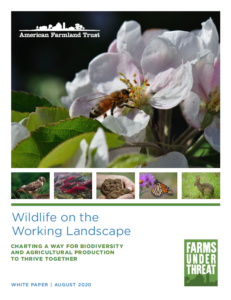This white paper by American Farmland Trust summarizes what researchers know about wildlife requirements, threats to biodiversity, the role that agricultural lands play, and what models and metrics can tell us about the capacity of agricultural lands to support wildlife habitat. To harness agricultural lands to protect biodiversity, we should: 1) protect agricultural land from conversion to urban and residential development, which is hugely disruptive to wildlife; 2) retire low-productivity agricultural land and restore habitat, especially where it can provide critical habitat and landscape linkages; and 3) manage working farms, ranches, and forests with wildlife-friendly practices, such as rotational grazing, vegetated riparian corridors, and sustainable forest management.
This white paper is part of AFT’s Farms Under Threat initiative, which is using advanced spatial analyses to analyze the status of and threats to agricultural land. A critical component of this initiative maps wildlife habitat and connectivity corridors on agricultural land. A companion effort looks at the critical ecosystem services and some of the disservices that agricultural lands provide. This geospatial work (see links below) will help inform efforts to balance the production of food, fiber, and energy with the need to conserve and safeguard biodiversity, and stabilize the climate.






